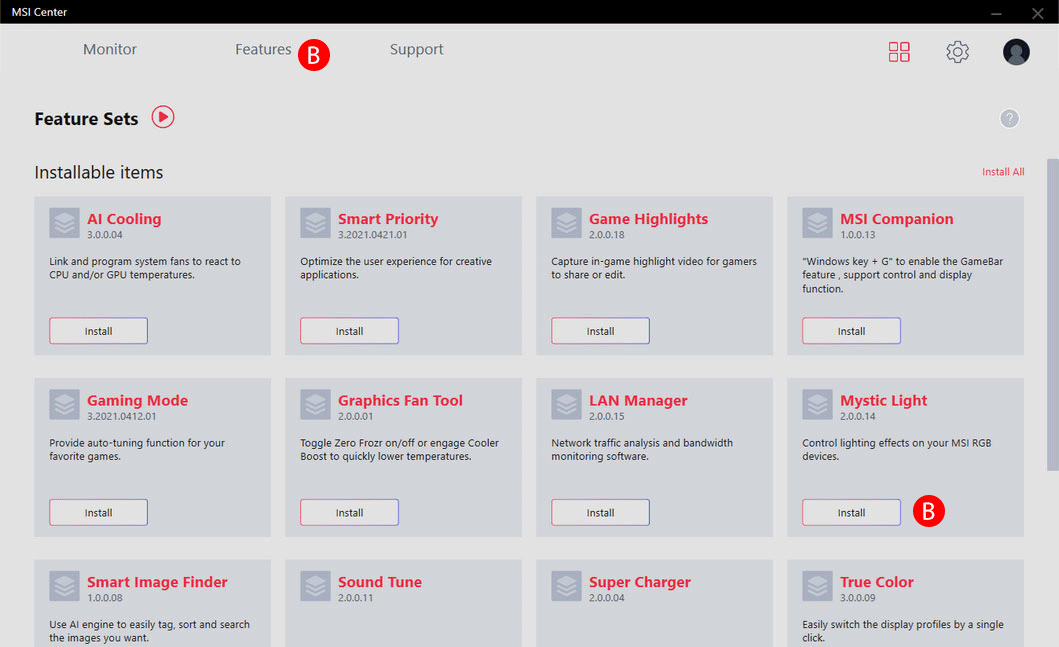


- #G SYNC MSI SOFTWARE HOW TO#
- #G SYNC MSI SOFTWARE INSTALL#
- #G SYNC MSI SOFTWARE DRIVER#
- #G SYNC MSI SOFTWARE FULL#
- #G SYNC MSI SOFTWARE PC#
Note that some games may work better or worse, depending on whether you run them in fullscreen or windowed mode (“fullscreen windowed” counts as windowed for this purpose). You’re good to go! Enjoy smoother gameplay in your favorite games.
#G SYNC MSI SOFTWARE FULL#
Click the check mark next to “Enable G-SYNC, G-SYNC Compatible.” Choose whether to enable it for full screen mode only or both windowed and full screen modes, depending on how you display your games.Ĭlick “Apply” to enable G-SYNC/FreeSync. In the Set Up G-SYNC screen, make sure your main monitor is selected if you have more than one.
#G SYNC MSI SOFTWARE INSTALL#
If you don’t see “Set up G-SYNC” as an option and you’re sure it’s enabled by your monitor, you might need to install drivers for your monitor manually. In the NVIDIA Control Panel, you should see “Set up G-SYNC” under the “Display” menu on the left side. You can also find a shortcut to the NVIDIA Control Panel in the Start menu or as an icon in the Windows Control Panel. Now, in Windows, open the NVIDIA Control Panel by right-clicking your desktop and selecting “NVIDIA Control Panel.” Go into the menu and make sure that the Adaptive Sync or FreeSync function is enabled. That’s the one that you activate via the physical buttons on the monitor. Once you’ve confirmed that your monitor is FreeSync compatible and you’re using a DisplayPort cable, check the on-screen menu of your monitor.

An NVIDIA GTX or RTX graphics card (laptops with internal discrete cards are fine too).A FreeSync (adaptive sync) capable monitor.Here’s what you’ll need to enable G-SYNC Compatible mode if your monitor isn’t certified by NVIDIA:
#G SYNC MSI SOFTWARE HOW TO#
How to Enable “G-SYNC Compatible” Mode on Any FreeSync Monitor You might see a noticeable improvement in your games’ smoothness, with the adaptive sync feature eliminating tearing at lower framerates. While your monitor might not pass NVIDIA’s rigorous internal testing standards, you can still try it out with the G-SYNC Compatible program. What if you have one of the hundreds of FreeSync monitors not on the list above? Don’t worry. In fact, at least one FreeSync monitor that’s not on the market yet, the new Razer Raptor, will be certified for G-SYNC before it’s even released. This list will grow as NVIDIA keeps testing a wider array of gaming monitors. It’s FreeSync! Only it’s called G-SYNC because you have an NVIDIA card.
#G SYNC MSI SOFTWARE DRIVER#
These twelve monitors are:ĭespite lacking the specialized G-SYNC hardware in G-SYNC-branded monitors, these monitors will automatically have G-SYNC enabled in NIVIDA’s driver if you connect them with adaptive sync enabled by the monitor itself. At CES, NVIDIA engineers told us they had independently tested hundreds of FreeSync monitors and found that only twelve passed its rigorous tests for panel quality, refresh consistency, color accuracy, and a gauntlet of other criteria. But it’s also selected a few FreeSync monitors that it thinks are worthy of its G-SYNC blessing (if not the official branding). Now, NVIDIA is making it very clear that it thinks the more expensive G-SYNC option, with NVIDIA hardware driving both the GPU and the monitor, is the superior choice. NVIDIA’s new support for FreeSync monitors is via a program called “G-SYNC Compatible.” NVIDIA GPUs now work with FreeSync monitors with “G-SYNC Compatible” enabled in the configuration tool. As of NVIDIA driver version 417.71, released on January 15, 2019, this is no longer a problem.
#G SYNC MSI SOFTWARE PC#
Here’s a more technical breakdown of G-SYNC and FreeSync.īut for several years, PC gamers with NVIDIA cards have lamented their lack of access to the adaptive sync/FreeSync capabilities on cheaper monitors. This module is manufactured and supplied by NVIDIA to its hardware partners, which is why G-SYNC monitors are almost universally more expensive than FreeSync monitors. Unlike FreeSync, which doesn’t need any additional hardware, G-SYNC monitors include a tiny computer module inside them to manage the syncing of frames rendered by the GPU and displayed by the screen. G-SYNC is NVIDIA’s branded alternative to adaptive sync/FreeSync. This allows the motion in the game to remain smooth without tearing. If the frame is slower than your monitor’s refresh rate, it will wait. This happens multiple times per second, faster or slower depending on how fast your PC and graphics card can render the frame. Adaptive Sync, often branded as “FreeSync” by AMD and its partners, is a feature that lets a monitor pause its screen refresh until an entire frame of animation is ready to load.


 0 kommentar(er)
0 kommentar(er)
